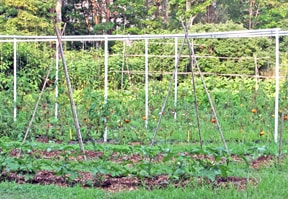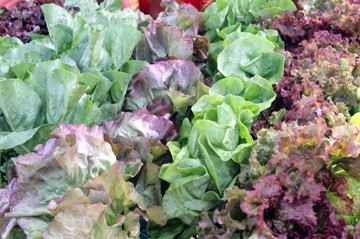Ok, so maybe you don’t want to plant a huge vegetable garden, let alone raise all of your own food. I’ll be the first to admit that growing fruits and vegetables takes work, and not everyone has the time or the inclination to make such an effort. But I will try and persuade you to include some pockets of edible plants in your landscaping. A patch of lettuce here, a few blueberry bushes there, and a small herb garden near the kitchen door. And how about a few tomato plants in the sunny area next to the garage? Come on…live a little: experience the joy of picking something fresh and bringing it to the table minutes later.
Some do raise vegetables because homegrown produce tastes better, and others so that they know their food is pesticide-free. Good reasons to start growing your own, but not the argument that I’m making here. I encourage you to grow some edibles in your landscape because it’s enjoyable. It’s fun to be able to pick some fresh herbs and toss them onto an otherwise plain baked potato or piece of fish. It’s enjoyable to cut multi-colored leaves of lettuce, wash them, and then sit down and eat your salad. And when you pluck ripe berries from a bush and pop them in your mouth it’s like finding treasure in your yard…small, tasty jewels, as pretty as they are delicious.
So how can you begin to have the pleasure of gobbling your garden? Fit the edibles into small spaces, and don’t (forgive me for saying this) bite off more than you can chew. Many a potential vegetable gardener has become discouraged when the large plot that they turned in the spring becomes a weed-ridden mess by late July. So start small, and make sure that you don’t get overwhelmed before your first crop is ripe for picking. Some suggestions for fitting edible landscaping onto your property and into your life:
- Plant lettuce seeds in between shrubs, in front of foundation plantings or in window boxes. Dig the area to loosen the soil in the early spring, and mix in compost while you’re at it. (You can buy bags of compost at any garden center if you don’t make your own.) If you’re planting in pots or boxes, use new potting soil. After the soil is turned over with the compost, smooth out the surface and scatter lettuce seeds on the top, pressing them in lightly. Keep the area moist while they germinate, and once the lettuce seedlings are about an inch or two high, pull out any plants that don’t look like lettuce. You can grow lettuce in places that get a great deal of sun, and those that get at least four hours of sun.
-

You can choose to plant edibles in a traditional vegetable garden, or you can place vegetables and fruit in small pockets throughout your landscape.
Speaking of sun, if you have an area where the sun shines for at least six hours you have the perfect place to grow herbs. Loosen the soil as above, and if you have really hard clay or pure sand, mix in the compost. But if you have regular garden dirt (loam) just plant the herbs in the unimproved soil – herbs don’t need overly fertile ground. Buy small plants of sage, basil, rosemary, thyme, parsley and chives, but if you want to have mint, keep it in a pot. Mint will eat your other plants for breakfast and the surrounding landscape for lunch.
- Grow blackberry bushes over an arbor or on a trellis. Blackberries grow in part shade, and many will form canes ten to fifteen feet long in one season. You can even buy thornless varieties that bear huge, sweet berries in late summer.
- Speaking of berries, blueberry bushes are attractive shrubs that demand only sun, acid soil and an annual pruning. Just plant enough so that you can share the crop with the chipmunks, squirrels and birds because you WILL share the feast with these critters. But when it comes to blueberries, more bushes make for better pollination anyway, so find a spot where you can plant five or more shrubs, spaced four or more feet apart. Loosen and amend the soil as above, in a wide diameter so that the plants can stretch out their roots and make themselves at home.
- If you grow tomatoes in pots, make sure they are BIG pots. Use topsoil mixed with compost to fill them instead of potting soil, and keep the containers evenly moist through the growing season. Many people have great success with EarthBoxes because they have a water reservoir that takes the guesswork out of watering. Fertilize tomato plants every three weeks or more, depending on the type of fertilizer you use and how the plants are growing. Fish and seaweed emulsion is a good organic fertilizer for tomatoes.
- If you have the notion to grow a particular vegetable or fruit, contact the closest cooperative extension for regional information. Most extension services have websites with fact sheets that will give you the scoop on the best varieties for your area and the most recent research.
So find a sunny spot and put something edible in your landscaping, because this is the thing: you aren’t just raising lettuce, berries and herbs. You’re growing fun and satisfaction.

